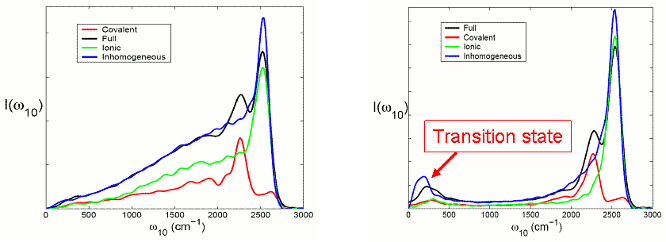

44850-AC6
Simulation of Photochemical Processes and Their Nonlinear Optical Signature via the Generalized Quantum Master Equation
The grant was used for partially supporting the following research projects that were carried out in collaboration with two graduate students and two postdoctoral fellows.
(A) The Nakajima-Zwanzig generalized quantum master equation provides a general, and formally exact, prescription for simulating the dynamics of a quantum system coupled to a quantum bath. In this equation, the memory kernel accounts for the influence of the bath on the system's dynamics, and the inhomogeneous term accounts for initial system-bath correlations. We developed a new method for calculating the memory kernel and inhomogeneous term for arbitrary initial state and system-bath coupling. We have also applied this methodology in order to analyze the homogeneity and Markovity of electronic dephasing of a two-state chromophore in liquid solution.
(B) We calculated nonlinear spectroscopic signals in liquid solution without treating the field-matter interaction in a perturbative manner. The utility and robustness of the nonperturbative procedure was demonstrated in the case of a two-state chromophore in liquid solution, by calculating nonlinear time-domain signals in the strong-field, weak-field, impulsive, and nonimpulsive regimes.

Figure 1: One-dimensional IR spectra (black) of the hydrogen stretch of the hydrogen-bonded complex, dissolved in a polar liquid, as obtained within the Condon (left panel) and non-Condon (right panel) treatments. Also shown are the corresponding spectra in the limit of inhomogeneous broadening (blue), and the relative contributions from the ionic (green) and covalent (red) tautomers. The low frequency peak in the non-Condon spectrum arises from the contribution of transition state configurations.
(C) The vibrational relaxation of a hydrogen stretch in a hydrogen-bonded complex in liquid solution is a multi-step process that involves solvation on ground and excited adiabatic surfaces, nonadiabatic transitions and proton transfer events. We simulated those processes via the mixed quantum-classical Liouville (MQCL) method, where the hydrogen is treated quantum-mechanically, while the other particles are treated in a classical-like manner. We also calculated one- and two-dimensional IR spectra of the hydrogen-stretch within an adiabatic mixed quantum-classical approach. We showed conclusively that non-Condon effects play a crucial rule in shaping the spectra of this system (see Fig. 1). In particular, we have shown that the great sensitivity of the transition dipole moment to the bath configuration provides new means for decongesting the spectra, probing statistically unfavorable bath configurations, such as transition-state configurations (see Fig. 1) and obtaining proton transfer rates (see Fig. 2). Finally, we studied the effect of substituting hydrogen by deuterium in the above mentioned solvated hydrogen-bonded complex on the vibrational relaxation and the corresponding one- and two-dimensional IR spectra. We found that the vibrational relaxation is similar for the deuterium and hydrogen stretches. At the same time, we have also found that isotope substitution modifies the IR spectra of the hydrogen/deuterium stretch in a qualitative manner. Our results demonstrated that isotope substitution may have a rather dramatic effect on the infrared spectra of a vibrational mode strongly coupled to its environment even though the rate and pathway of vibrational relaxation may not be overly sensitive to it.
(D) Still ongoing projects deal with other aspects of vibrational relaxation and spectroscopy of hydrogen-bonding in liquid solution: (1) A systematic study of the signature of the hydrogen bonding strength on the vibrational relaxation and IR spectra of the hydrogen stretch; (2) A new approach for computing nonlinear spectra from nonequilibrium MQCL simulations, without assuming hat the dynamics takes place on the ground state potential; (3) A nonperturbative calculation of spectra which does not rely on assuming weak field-matter interaction and impulsive pulses.

Figure 2: The two-dimensional IR spectra of the hydrogen stretch of the hydrogen-bonded complex, dissolved in a polar liquid, as a function of the waiting time between the first and second and third pulses (t2), as obtained within the Condon and non-Condon treatments. The emergence of off-diagonal peaks at t2=5-7ps is the signature of proton transfer.